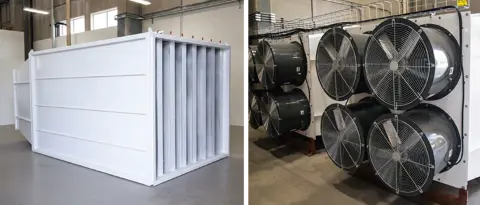Completing the Loop: Origen Commissioning Proprietary Air Contactor
September 2025
Last month, we commissioned Origen’s zero-emission kiln at the Energy & Environmental Research Center (EERC), demonstrating zero-emission lime production at scale. Today, we are excited to announce that the system’s second critical component, our proprietary air contactor, is coming online. Together, these technologies complete Origen’s full limestone Direct Air Capture (DAC) cycle at large scale for the first time.
How Origen’s Limestone DAC Cycle Works
- Kiln – Our proprietary kiln prepares limestone by releasing the CO₂ it contains, producing high-performance lime and a pure stream of CO₂ for permanent storage.
- Lime Processing – Origen’s patent-pending processing method turns lime into robust, highly reactive granules that retain surface area while solving key materials-handling challenges.
- Contactor – The processed lime reacts with atmospheric CO₂ inside Origen’s proprietary low-intensity air contactor, reforming limestone that is fed back into the kiln to complete the loop.
Why Air Contacting is a Challenge in DAC
Capturing CO₂ from ambient air, where it exists at just ~0.04% concentration, is one of the toughest challenges in DAC. The underlying chemistry works, but how you design the system makes all the difference for cost and scalability.
Common challenges include:
- Batch size limits – Smaller batches of reactive material require more surface area, driving up the size and cost of structures, while frequent cycling adds operating expense.
- Expensive sorbents – Some DAC pathways rely on rare or complex materials that are costly to produce and difficult to scale.
- Materials handling – Powders and pastes can generate dust, losses, and wear on equipment, creating added operational challenges.
- System complexity – Operating at scale may require thousands of components with extensive mechanical systems to move and cycle material.
In short: pulling CO₂ out of the air is simple in theory, but system design determines whether it can be done at scale and at cost.
Origen’s Breakthrough Approach
Origen has taken a fundamentally different path. Through our patent-pending lime processing method, we create durable granules that retain high surface area for CO₂ capture while being compact, stackable, and easy to handle. This innovation allows us to operate with larger batches, longer carbonation cycles, and simpler structures, dramatically reducing the cost of removal and avoiding operational bottlenecks and risks.
Origen’s system enables:
- Larger batches of reactive material that still carbonate deeply and efficiently, requiring only light fan use.
- Simple, low-CAPEX contactor structures built from standard materials.
- Easier handling and reduced losses, avoiding operational complexity and cost.
The result is an elegant, cost-effective, and highly scalable air contacting system – one that works in tandem with our kiln to deliver efficient, end-to-end limestone-based DAC.

The Case for Limestone
Many DAC approaches rely on novel, manufactured sorbents or solvents that cost hundreds to thousands of dollars per tonne. By contrast, Origen’s approach uses limestone: an abundant, low-cost natural material with well-understood chemistry that has been used for millennia.
This foundation gives limestone-based DAC a uniquely promising cost and scalability profile:
- Low technical risk – built on well-understood, thousand-year-old chemistry.
- Cost-effective material – limestone costs on the order of ~$30/tonne, vs. ~$1,000/tonne for manufactured sorbents.
- Widely abundant supply chain – limestone and its transport network are already available globally.
Origen’s proprietary system is designed to build on these advantages, turning limestone’s natural strengths into a practical pathway for affordable, large-scale carbon removal.
Why This Milestone Matters
What makes this milestone significant is not just the hardware, but the approach. Origen is focused on practical, scalable systems designed for industrial deployment. We leverage simple structures, stable materials, and processes that can be built and operated reliably at the scale required for meaningful climate impact. These are systems that draw on technologies proven in other industries to work at megatonne scale. With the air contactor now commissioned, Origen is showing a pathway for DAC that is pragmatic, cost-conscious, and ready to deploy.
Looking Ahead: From Demonstration to Deployment
With both kiln and contactor coming online at EERC, Origen will begin integrated testing of the full system, looping limestone through the cycle at scale. This milestone positions us to move quickly toward commercial deployment, including the Pelican DAC Hub in Louisiana, a partnership with Shell and Mitsubishi.
Each step brings us closer to rapid, cost-effective scaling of our breakthrough direct air capture system. The climate clock is ticking, and Origen is ready to meet the challenge.
